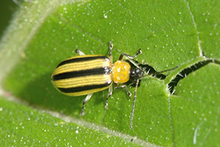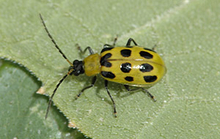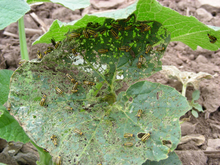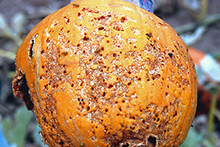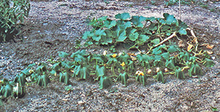Quick facts
- Striped cucumber beetles and spotted cucumber beetles are pests in Minnesota
- Both species can be found on cucurbits (squash, cucumbers, melons, etc.).
- Cucumber beetles can damage foliage and fruit.
- Striped cucumber beetles can transmit the bacterial wilt pathogen that can kill cucurbits.
- Cantaloupe and muskmelons are severely affected by bacterial wilt.
-
There are nonchemical and chemical options available for managing cucumber beetles.
Cucumber beetles become active in late May or early June and feed on the blossoms of early flowering plants, such as dandelions, apples and hawthorn, until their host crops are available.
How to identify cucumber beetles
Adult striped cucumber beetle (Acalymma vittatum)
- About 1/5 inch long, 1/10 inch wide.
- Have yellow wings with three longitudinal black stripes.
- Has a black head and antennae.
- Has an orangish prothorax (the first area behind the head).
Adult spotted cucumber beetle (Diabrotica undecimpunctata howardi)
- Similar in size, shape and color.
- Instead of stripes, this beetle has 12 black spots on its wing covers.
Larvae of both species are small (3/8 in) and creamy white colored. Eggs of both species are pale orange-yellow and are laid in groups.
Biology of cucumber beetles
Striped cucumber beetles
They live through the winter as adults in leaf litter and emerge in late May to early June.
- Adults feed on blossoms of flowering plants, mate and lay eggs in the soil at the base of host plants (cucumber, squash, etc.).
- Eggs hatch in several weeks and larvae feed on plant roots and underground parts of stems.
- Larvae transform to pupae in the soil and emerge later in the summer as adults.
- Adults return to cucurbit plants and feed on the foliage later in the summer.
- It takes about 40 to 60 days to go from an egg to an adult.
- There is typically one generation per year.
Spotted cucumber beetles
- Do not live through the winter in Minnesota.
- Adults migrate from the Southern U.S. in late June or early July.
- Adults lay eggs on non-cucurbit plants such as corn and other grasses.
- Larvae feed on the roots of grasses and transform to pupae in the soil.
- It takes about 40-60 days from egg to adult and there is only one generation per year.
Damage caused by cucumber beetles
Feeding damage by striped cucumber beetles
- Larvae feed on cucurbit roots and underground portions of the stems. This feeding does not affect plant health.
- Adults feed on the foliage, and when populations are high, they feed on the stems as well.
Adult feeding is most damaging up to the third true-leaf stages of cucurbit plants.
- The plants are small enough that high populations can either defoliate the plants completely or girdle the stem.
- Several cucurbits can tolerate high levels of defoliation after the third true-leaf stage.
- Striped cucumber beetles will usually move off the foliage and begin feeding on fresh blossoms and pollen.
- Fruit or flower feeding is not concerning and feeding on fruit only affects the appearance.
Bacterial wilt
Striped cucumber beetles can carry the bacteria that causes bacterial wilt.
- The bacterium infects the plants' vascular system and causes plants to wilt.
- Once the plant is infected, it cannot be saved.
- Striped cucumber beetles pick the bacterium when they feed on infected weed hosts or infected cucurbits.
Infected plants wilt and leaves can discolor before eventually dying. Wilting can spread rapidly and within a few days the entire plant can die. Not all cucurbits suffer the same amount of damage:
- Cucumbers and muskmelon are most affected.
- Squash, pumpkin and watermelon are generally very tolerant or resistant to bacterial wilt.
To check if your plant is infected with bacterial wilt take a stem that exhibits symptoms from a plant and cut it in half.
- Hold the two cut ends together for 10-15 seconds and slowly pull them apart.
- If bacterium is present, there should be whitish bacterial ooze that forms a mucus-like string between the two cut ends.
This technique is sometimes difficult to use for diagnosis and should not be used as the only indication that the bacterium is either present or absent.
Do not confuse bacterial wilt with other cucurbit problems. Squash bugs and squash vine borers can cause leaves to wilt. Watch for heavy numbers of squash bugs or orangish frass leaking from stems (a symptom of squash borer damage). Squash family plants can also wilt when suffering from drought.
How to protect your garden from cucumber beetles
Check for cucumber beetles early in the season
- Pay attention to plants in the cotyledon and first to third true-leaf stage, when the plants can suffer defoliation and bacterial wilt.
- Be attentive until fruiting as larger plants can be affected by bacterial wilt as well.
- Concentrate your efforts on striped cucumber beetles. It is rare to see spotted cucumber beetles early in the season and their numbers normally are too low to require treatment.
Keep your garden clean
Remove weeds in and around your garden because they may be potential hosts for adults.
- During the planting season apply a heavy layer of mulch around established cucurbit plants to discourage egg laying.
- If a plant is showing signs of bacterial wilt, remove the infested plant before more beetles can feed on the plant and spread the bacterium.
- After the summer ends, remove garden debris and leaf litter to reduce sites for adult beetles to spend the winter.
Use trap crops
A trap crop is a plant that attracts pests away from your main garden plants.
- Plant a few highly attractive cucurbits prior to planting your garden cucurbits
- Once striped cucumber beetle numbers build up in these traps, treat them with an effective pesticide to minimize further movement.
Use a physical barrier
You can try to protect your cucurbits by building a floating row cover or similar barrier during early to mid-June to keep the striped cucumber beetles away from your plants.
Be sure to remove the barrier when cucurbits start to flower.
Using pesticides
Use pesticides only when necessary.
Watch your plants regularly for striped cucumber beetles when new leaves are coming up from seed leaves. If you find two or more beetles/plant on 25% of your plants in the cotyledon stage, apply a pesticide.
- Once beetles are present, monitor more frequently (every couple of days).
- Once plants are at the second or third true-leaf stage, check the defoliation level.
- Monitoring the defoliation level is much faster and still allows for the detection of bacterial wilt.
- If you find 25% of a given plant defoliated, apply pesticides.
Striped cucumber beetles seen later in the summer can be ignored as they cause little or no damage.
Low impact pesticides
Choose a pesticide that has a low impact on natural enemies, such as lady beetles and pollinators.
- Neem is a plant based pesticide that prevents insects from feeding, which eventually kills them.
- Pyrethrins have no residual and treatments need to come in contact with the beetles to be effective.
Conventional or broad-spectrum pesticides
They are longer lasting but can kill a variety of insects, so use them carefully and judiciously. Examples of broad-spectrum pesticides available include: permethrin, bifenthrin, lambda-cyhalothrin and carbaryl.
CAUTION: Mention of a pesticide or use of a pesticide label is for educational purposes only. Always follow the pesticide label directions attached to the pesticide container you are using. Remember, the label is the law.
Be sure that the vegetable you wish to treat is listed on the label of the pesticide you intend to use. Also be sure to observe the number of days between pesticide application and when you can harvest your crop.
Reviewed in 2020


